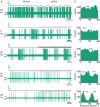This is a preprint.
Cerebellar transcranial AC stimulation produces a frequency-dependent bimodal cerebellar output pattern
- PMID: 39606464
- PMCID: PMC11601861
- DOI: 10.21203/rs.3.rs-5147104/v1
Cerebellar transcranial AC stimulation produces a frequency-dependent bimodal cerebellar output pattern
Update in
-
Cerebellar Transcranial AC Stimulation Produces a Frequency-Dependent Bimodal Cerebellar Output Pattern.Cerebellum. 2025 Jan 2;24(1):21. doi: 10.1007/s12311-024-01756-0. Cerebellum. 2025. PMID: 39745631
Abstract
Transcranial alternating current stimulation (ctACS) has the potential to be an appealing, non-invasive treatment option for psychiatric and neurological disorders. However, its potential has been limited by significant knowledge gaps in the details and mechanisms of how ctACS affects cerebellar output on single cell and population levels. We investigated this issue by making single-unit recordings of Purkinje cells (PC) and lateral cerebellar nuclear (Lat CN) cells in response to ctACS in anesthetized adult female Sprague-Dawley rats. The ctACS electrode was positioned directly on the skull above crus 1, either ipsilaterally just medial to the recording site or contralaterally. The return electrode was placed under the skin of the shoulder ipsilateral to the recorded cell. In response to ctACS at frequencies ranging from 0.5 to 80 Hz, PC and CN activity was modulated in a frequency-dependent manner. PC and CN entrainment strength increased with stimulation frequency. Moreover, a unimodal response was seen for most PCs across all frequencies, whereas most CN cells transitioned to bimodal patterns as stimulus frequency increased. The phase of the local minima CN cells, and its change with frequency, was consistent with CN cells being driven synaptically by PC activity. Furthermore, the nearer ctACS location to the recording site, the stronger the entrainment, suggesting that ctACS electrode placement could be used to target specific cerebellar output channels. In sum, the results show that transcranial stimulation of the cerebellar cortex can modulate cerebellar output, which has potential implications for its use in treating neurological and psychiatric disorders.
Keywords: Purkinje cell; cerebellar nuclei; electric fields in neural tissue; transcranial electrical stimulation.
Conflict of interest statement
Additional Declarations: No competing interests reported. Declarations Conflict of Interest: The authors declare no competing financial interests. Competing Interests The authors declare no competing interests.
Figures













References
-
- Fertonani A, Ferrari C, Miniussi C. What do you feel if I apply transcranial electric stimulation? Safety, sensations and secondary induced effects. Clin Neurophysiol. 2015;126:2181–8. - PubMed
-
- Grimaldi G, Argyropoulos GP, Boehringer A, Celnik P, Edwards MJ, Ferrucci R, et al. Non-invasive Cerebellar Stimulation—a Consensus Paper Cerebellum. 2014;13:121–38. - PubMed
Publication types
Grants and funding
LinkOut - more resources
Full Text Sources
Research Materials

